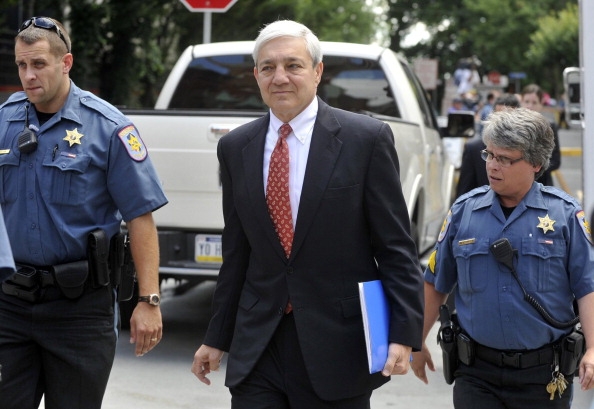You have /5 articles left.
Sign up for a free account or log in.

Graham Spanier leaves a court hearing in 2013.
Centre Daily Times / Getty Images
Graham Spanier, former president of Pennsylvania State University, lost an appeal Tuesday to overturn his misdemeanor conviction for endangering the welfare of a child. The 2-to-1 ruling in the Superior Court of Pennsylvania, the state’s first appeals court, is another nail in the coffin for the legacy of the once-celebrated leader in higher education.
Spanier was convicted on June 2, 2017, after failing to adequately respond to reports of child molestation by Jerry Sandusky, a former assistant football coach at Penn State who is now serving 30 to 60 years in prison for the sexual assault of numerous children. Spanier could spend up to 12 months in prison with two years of probation.
Spanier maintains his innocence. When asked about plans for another appeal, Sam Silver, a defense attorney on Spanier’s case, issued the following statement to Inside Higher Ed:
“Dr. Spanier is deeply disappointed with the Superior Court’s ruling. He has always maintained his innocence of the charges brought against him, and he intends to pursue his appellate options so that he ultimately will be vindicated.”
In the majority opinion, Judge Victor P. Stabile, joined by Judge Carolyn H. Nichols, rejected claims that too much time had passed to charge Spanier, that he was not responsible for safeguarding the welfare of the boys that Sandusky abused and that he could not be charged because he was not directly supervising the boys.
Judge Lillian Harris Ranson issued a dissent and argued that the court had violated Spanier’s due process rights “when it failed to inform him of its intent to rely upon an exception to the statute of limitations at a reasonable time before trial.”
The criminal charge against Spanier is not about Sandusky's initial offenses, but about whether the abuse of others could have been prevented had Spanier and other Penn State officials responded more seriously to reports that authorities say should have raised questions about Sandusky. Two former Penn State officials, athletic director Tim Curley and vice president Gary Schultz, pleaded guilty to misdemeanor charges of child endangerment and testified against Spanier, saying that they all should have done more to prevent subsequent abuse.
In May of 1998, the mother of a 11-year-old boy who was involved in Sandusky’s charity program, the Second Mile, contacted Penn State police to report that Sandusky had “bear hugged” her son while both were naked in the shower. Spanier was copied on emails discussing the resulting investigation, but no criminal charges were filed against Sandusky and the university took no further action against him.
In February 2001, Michael McQueary, a graduate assistant for the Penn State football team, witnessed Sandusky sexually assaulting a 10- to 12-year-old boy in the shower of the Lasch building. McQueary told head football coach Joe Paterno, now deceased. A day later, Paterno contacted Curley, who in turn informed Schultz.
Curley and Schultz met with Spanier to discuss the incident and devised a three-part plan that entailed speaking with Sandusky about the appropriate use of facilities and contacting the coordinator of the Second Mile and the Department of Public Welfare. The plan was never carried out, and Curley spoke again with Spanier to express discomfort with the original plan. The two agreed that Curley would instead speak with Sandusky about seeking professional help and forbid him from bringing young boys to Penn State facilities. They would only inform the Second Mile. Spanier mentioned to Curley that if Sandusky did not cooperate, they would be vulnerable for neglecting to report the incident.
Sandusky denied wrongdoing when Curley spoke to him, and Curley never informed campus police or other Penn State officials that Sandusky was no longer allowed to bring children into facilities. McQueary saw Sandusky in the Lasch building after hours on subsequent occasions. Sandusky abused at least four more boys before he was arrested in 2011, including one in the Lasch building shower in 2002.




